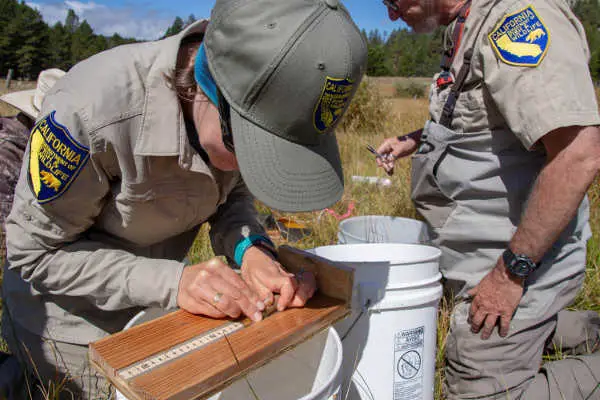
California's native Paiute cutthroat trout, the rarest trout in North America, swims once again in its high Sierra home waters for the first time in more than 100 years.
California Natural Resources Secretary Wade Crowfoot, California Department of Fish and Wildlife Director Charlton H. Bonham and representatives from the USDA Forest Service, U.S. Fish and Wildlife Service, Golden Gate Chapter of Trout Unlimited and Little Antelope Pack Station joined biologists to release 30 Paiute cutthroat trout of varying sizes into Silver King Creek in Alpine County on Sept. 18.
"You've got to celebrate good times. That's what we're doing here today," said CDFW's Bonham from the banks of Silver King Creek within the remote Carson-Iceberg Wilderness area of the Humboldt-Toiyabe National Forest. "If you forget to celebrate, you're overlooking a remarkable success story - bringing these fish back home and celebrating a better California."
Not since the early 1900s have genetically pure Paiute cutthroat trout occupied the 11-mile stretch of Silver King Creek between Llewellyn Falls and Snodgrass Creek that represents almost the entirety of the fish's historic range.
"This is a lifetime achievement for those working to recover the rarest trout in North America," said Lee Ann Carranza, acting field supervisor for the USFWS Reno office. "This remarkable partnership has allowed Paiute cutthroat trout to be returned to their entire native range without threat from non-natives."
The Paiute cutthroat trout was one of the first animals in the nation listed as endangered in 1967 under the federal Endangered Species Preservation Act of 1966, now known as the Endangered Species Act. In 1975, the species was downlisted to federally threatened to allow for a special rule that would facilitate management of the species by the State of California.
A small native range, habitat degraded by historic sheep and cattle grazing, and competition from and hybridization with non-native trout introduced into Silver King Creek threatened the species with extinction.
Only a fortuitous turn of events saved the species from disappearing altogether. In the early 1900s, Basque sheepherders moved some of the fish outside of their native range, upstream of Llewellyn Falls. The waterfalls served as a barrier to the non-native trout below and safeguarded a genetically pure population of Paiute cutthroat trout above the falls, providing government agencies and advocates the chance to recover the species in the future.
Efforts to save and restore the species have spanned several decades and involved removing non-native fish and restocking Paiute cutthroat trout from source populations. Recreational fishing was closed within the Silver King Creek drainage in 1934. Later, grazing allotments were administratively closed so habitat could be restored.

At one time, only two small tributaries above Llewellyn Falls held genetically pure Paiute cutthroat trout. CDFW, the Forest Service and USFWS transferred some of these fish to other fishless, protected streams within the Silver King Creek watershed as well as four watersheds outside of the basin to create additional refuge populations to stave off extinction.
The effort to reintroduce Paiute cutthroat trout back into their historic home – the 11-mile main reach of Silver King Creek – began in 1994 when CDFW biologists explored Silver King Canyon and identified a series of waterfalls that served as historic barriers to upstream fish migration, isolating the Paiute cutthroat trout. The barriers could once again insulate Paiute cutthroat trout from encroachment from non-native trout if the non-native trout in Silver King Creek could be removed.
Wildlife officials prevailed over a decade of legal challenges to treat Silver King Creek and its tributaries with rotenone, a natural fish poison, to eliminate non-native trout and prepare Silver King Creek for the eventual return of Paiute cutthroats.
Silver King Creek and its tributaries were chemically treated from 2013 to 2015. State and federal partners monitored the creek for three years following the treatment to make sure all non-native fish were removed. Wildfires, floods and drought over the decades further complicated recovery efforts.
"The commitment of Forest Service, CDFW, USFWS, Lahontan Regional Water Quality Control Board, Trout Unlimited Golden Gate Chapter and Little Antelope Pack Station to move this project forward in the face of numerous challenges has been incredible," said Bill Dunkelberger, Humboldt-Toiyabe National Forest supervisor. "A project of this magnitude that took over several decades could not have been completed without state, federal and other partners working tirelessly together."
The fish reintroduced into Silver King Creek on the afternoon of Sept. 18 were collected that morning from a source population in Coyote Valley Creek about 2 miles away and transported by mules to the banks of Silver King Creek. The fish were deposited into buckets filled with water from Silver King Creek to acclimate for several minutes before being released among cheers and applause - and a few tears - by biologists and others, some of whom have spent decades working toward the historic homecoming.
Restoring Paiute cutthroat trout to their native Silver King Creek nearly doubles the amount of habitat available to the fish and is considered key to their long-term survival and potential delisting.
Monitoring of the reintroduced fish and additional restocking of Paiute cutthroat trout into Silver King Creek from other refuge populations is planned in future years to aid genetic diversity and introduce different age classes into the creek to help natural reproduction.


 How to resolve AdBlock issue?
How to resolve AdBlock issue? 





